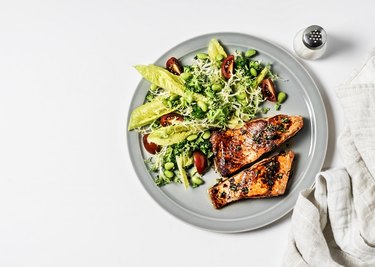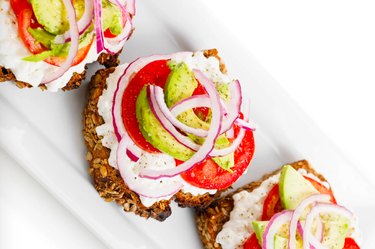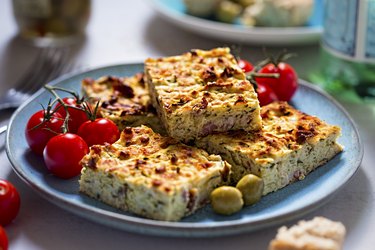
A 50-30-20 macros diet, also called IIFYM or flexible dieting, is a popular option because instead of restricting certain foods, it focuses on counting the total number of macronutrients (aka macros) you eat.
This approach allows more flexibility in your diet and gives you the freedom to choose the foods you like. The idea is that as long as you're staying within the guidelines of 50-30-20, weight loss will come naturally.
Video of the Day
Video of the Day
However, there isn't one 50-30-20 meal plan that's right for everyone across the board. Some people prefer to get 50 percent of their calories from carbohydrates, while others get half of their calories from fat or protein. Once you make that choice, you can design your meal plan around nutrient-dense foods.
Figure Out Your Calorie Needs
IIFYM is an acronym that stands for "If It Fits Your Macros." Also called "flexible dieting," IIFYM is not a rigid diet — it's a dietary guideline that allows you to be more flexible with your food choices as long as you're staying within your macro needs.
With IIFYM, you calculate how many calories you need. Then, you use that number to determine which percentage of calories should come from each of the macronutrients — carbohydrates, protein and fat.
For example, if your daily needs include 1,200 calories and you prefer to get most of your intake from carbohydrates, then you should consume 600 calories from carbs, 360 calories from protein, and 240 calories from fat. While this 50-30-20 macros diet allows some flexibility, other forms like the 50-20-30 diet suggest consuming 50 percent of your calories come from carbohydrates, 20 percent from fats and 30 percent from proteins.
The underlying theory of IIFYM is that it doesn't matter what you eat — as long as you're not eating too many calories and your macronutrients stay within a personalized ratio. A January 2013 study in Eating Behaviors reported that people who follow diets that allow greater variability in food choices, like IIFYM, are more likely to stick to the diet and maintain weight loss over time.
When designing a diet around macronutrients, the first thing you need to do is figure out your exact calorie needs. This will depend on your age, your sex assigned at birth, your current height and weight and your activity level. The amount of calories you need to eat also depends on what your goals are. If you're trying to lose weight, you'll need fewer calories than if you're trying to build muscle, for example.
After you decide what your goals are, you can use a calorie-tracking app to quickly generate a specific number for you. Once you have that number, you can use it to calculate your 50-30-20 macros.
Your 50-30-20 Macros
A typical 50-30-20 macros diet is broken down into:
- 50 percent carbohydrates
- 30 percent protein
- 20 percent fat
But if your goal is to improve your health while you lose weight, you may want to switch those numbers around.
An October 2015 PLOS One study compared the effects of low-carb diets and low-fat diets on weight loss in participants with overweight and obesity. While both groups lost weight, weight loss in the low-carb diet group was significantly greater, and participants reaped the added benefit of improved cardiovascular factors, like lower LDL, or "bad," cholesterol and higher HDL, or "good," cholesterol.
To add to that, a July 2013 Diabetes Care study compared restricted calorie high-protein diets (40 percent of calories from protein and 40 percent of calories from fat) to restricted calorie high-carbohydrate diets (55 percent of calories from carbohydrates) and found that after six months, the high-protein diets improved insulin sensitivity, lowered inflammation and decreased oxidative stress to a greater degree than the high-carbohydrate diets.
What's more, an October 2015 study in the American Journal of Clinical Nutrition compared the effects of a high-carb diet, which provided 53 percent of calories from carbs, and a low-carb diet, which provided 53 percent of calories from fats, on participants with obesity and diabetes. While both groups were able to successfully lose weight and lower their blood sugar levels, the group on the low-carb diet ended up with better cholesterol and triglyceride numbers and were able to control their blood sugar better.
One of the biggest benefits of a 50-30-20 diet is that you can design it around your goals and personal preferences. Whether you decide to get 50 percent of your calories from carbohydrates, 30 percent from protein and 20 percent from fat or you prefer to take a low-carb, more keto diet approach and get 50 percent of your calories from fat, 30 percent from protein and 20 percent from carbohydrates, there are some basic guidelines you can follow to develop your menu plan.
Related Reading
50-30-20 Macros Diet Guidelines
But even though a 50-30-20 diet gives you some more flexibility with your food choices, you should still do your best to design a nutritious plan. Doughnuts and cookies might fit into your 50-30-20 macros, but that doesn't mean it's a good idea to work them into your diet every day.
Nutrition statistics show that people who focus only on macronutrients eat less than the recommended amount of micronutrients (vitamins and minerals) for the day, according to a September 2018 International Journal of Sport Nutrition and Exercise Metabolism study. This effect was also seen with rigid dieters, so it's not an isolated IIFYM concern, but it's something to consider when developing your 50-30-20 recipes and meal plans.
To make sure you're optimizing your micronutrient intake, always fill at least half your plate with non-starchy vegetables. Focus on variety with your vegetables, too: Instead of eating broccoli every day, eat lots of different kinds (and different colors) of vegetables to make sure you're getting a variety of vitamins and minerals.
Always add lean protein to every meal. You can choose from lean beef, pork, chicken, eggs, nuts or beans. The USDA recommends making seafood your protein choice at least twice a week. Aside from that, you can optimize the amount of vitamins and minerals you're getting by focusing on eating lots of nutrient-dense foods, which are foods that give you a lot of nutrients for a relatively low number of calories.
Here's a list of nutrient-dense foods to get you started, per Harvard Health Publishing:
- Avocados
- Swiss chard
- Collard and mustard greens
- Kale
- Spinach
- Brussels sprouts
- Bell peppers
- Mushrooms
- Sweet potatoes
- Berries
- Yogurt
- Eggs
- Flax seeds, chia seeds and pumpkin seeds
- Beans
- Lentils
- Almonds
- Eating Behaviors: "Cognitive and Weight-Related Correlates of Flexible and Rigid Restrained Eating Behaviour"
- International Journal of Sport Nutrition and Exercise Metabolism: "A Comparison of the Nutrient Intakes of Macronutrient-Based Dieting and Strict Dieting Bodybuilders."
- Diabetes Care: "Effects of High-Protein Versus High-Carbohydrate Diets on Markers of β-Cell Function, Oxidative Stress, Lipid Peroxidation, Proinflammatory Cytokines, and Adipokines in Obese, Premenopausal Women Without Diabetes"
- American Journal of Clinical Nutrition: "Comparison of Low- and High-Carbohydrate Diets for Type 2 Diabetes Management: A Randomized Trial"
- PLOS One: "Dietary Intervention for Overweight and Obese Adults: Comparison of Low-Carbohydrate and Low-Fat Diets. A Meta-Analysis"
- USDA ChooseMyPlate: "10 Tips: Build a Healthy Meal"
- Harvard Health Publishing: "Getting Your Vitamins and Minerals Through Diet"

